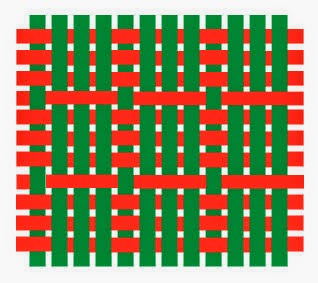Weaving is the interlacing of two sets of yarn which inter-lace at right angles to each other. The length-wise threads are known as warps, individually they are called ends. The cross-wise threads are known as filling or weft; individually they are known as picks. Weaving is done on a loom which makes it possible to interlace the warp and filling threads according to a pre-arranged manner. The length-wise edges of the fabric are called selvages. Woven fabrics are produced by weaving.
Characteristics Of Woven Fabrics
Count Of Cloth Or Thread Count
The yarns of warp and yarns of filling are not incessantly of the same diameter. Also those utilized in one direction may be closer together than those of the other direction. Often there are more warp yarns than filling yarns to the inch since the strain on a fabric falls on the warp.
Some cloths like gingham are close woven while those like voile are loose woven. A closely woven fabric keeps its shape shrinks-less, slips-less at the seam and is more durable than a loosely woven cloth. The closeness or looseness of the weave is measured by the count of cloth. This is conditioned by the number of picks and ends to the square inch be changed by shrinkage during drying and finishing.
With the warp number thread count is written first, e.g. if there are 60 warps and 50 fillings to the inch then the count is 60 X 50. Thread count indicates the quality of a fabric. There are high count and low count clothes. The count is made with a thread counts. A small pocket magnifying glass, called a pick glass or linen tester is used for counting –
– Many warp yarns and many filling yarns are removed from the cloth.
– If the fabric is light in color, a cut of black material is put under it or vice versa.
– The tester is put on the raveled edge.
– Since the opening in the tester is ¼” square, the yarns are counted (first number of warps then of filling).
– Then number of yarns that run every way is multiplied by four to receive count per inch.
– A pin sometimes supports to separate the yarns.
Balance Of Cloth
The ratio of warp yarns to filling yarns is known as the balance of a cloth. If the number of warps and number of fillings to the inch are nearly the same (not more than 10 yarns difference) a cloth is said to have a good balance for instance if the count is 60 X 50, it would be a well. If the cloth has poor balance than the warp yarns have a tendency to slip over the filling yarns. Shirts, pillow slips and towels which have various washing must have a good balance.
Selvage
A selvage is the self-edge of a fabric formed by filling yarn when it turns to go back across the fabric. They are made in many ways –
– Plain selvages: These are corresponding to the rest of the fabric. They do not shrink and can be used for seam edges in garments construction.
– Tape selvages: They are prepared of larger and for ply yarns to give strength. They are wider than the plain selvages.
– Split selvages: They are used when narrow items, such as towels are made by weaving two or more side by side cutting them apart after weaving. The cut edges are finished by a machine, chain-stitch or hem.
– Lased selvages: They are the heat sealed edges of ribbon generally utilized for synthetic fibres.










